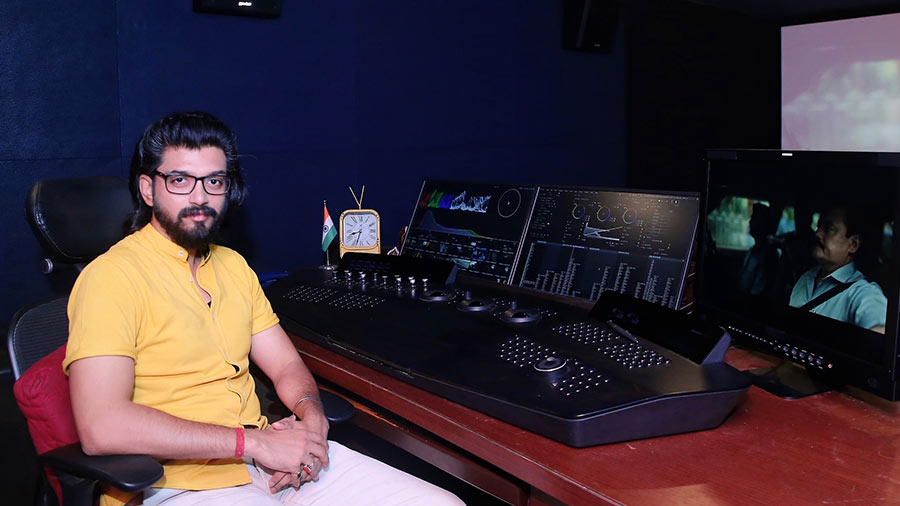We’ve all often come out of movie halls commenting on how we liked the play of shadow and light in a film, or how dreamy everything looked or how the greenish tone made all the difference. And while it is definitely the director’s vision, the cinematographer’s execution and the editor’s skills, there is another person who is crucial to the magic that is woven on screen. And that is the colourist. And Kolkata has slowly but steadily gained a reputation nationally as the go-to place for colour grading and correction. All thanks to Debojyoti Ghosh who, in his decade’s work as a colourist at Edit FX Studios, has just completed his 200th film!
“I joined Edit FX as an editor while I was still in my third year of college. I mostly edited promos then and I was thinking that I would eventually choose editing as my career. It was then that the proprietor of Edit FX, Harcharan Singh, told me that the studio was getting into digital films and suggested that I think about working as a colourist,” said Ghosh, at his workstation with a scene from Sherdil: The Pilibhit Saga frozen on the projector screen in front of him.
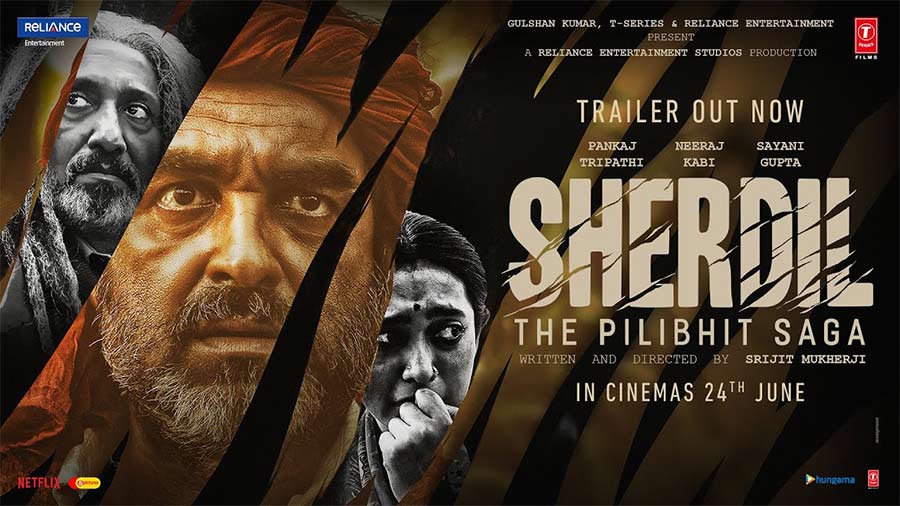
Poster for ‘Sherdil’, written and directed by Srijit Mukherji
In 2009, there was no colourist working in Kolkata. Ghosh, who had stumbled into editing software as a gamer in school and picked up skills through online tutorials before he did a two-year multimedia course at Arena, started researching the work and learning through trial and error. He also got in touch with a couple of people in Mumbai and one person agreed to give him basic training as a colourist.
1 to 200, with Avik and Aniruddha!
But most of his learning happened on the job with his first film, Ekti Tarar Khonje, which was directed and shot by cinematographer Avik Mukhopadhyay and produced by filmmaker Aniruddha Roy Chowdhury. Mukhopadhyay sat with him in post-production to do the colour grading of the film. “That was a huge learning experience for me. I had gone to Mumbai for the print as well, because at that time there were still positive prints. I learnt how prints are made, the chemicals, the process. After that I was suddenly thrown into commercial films. My second film was Autograph, with Srijit Mukherji, and then Memories in March with Rituparno Ghosh. I didn’t have the time to go somewhere and get professional training as a colourist,” said Ghosh, who later had the opportunity to attend some courses abroad, one in Singapore and another in France.
Today, exactly 12 years after Ekti Tarar Khonje, Ghosh is a busy man in high demand. At any given time, he has five to six active projects that he juggles with a team he has trained. “I have just wrapped up my 200th film now, Lost. And the best thing is that it was with the two people I had done my first film — Aniruddha Roy Chowdhury and Avik Mukhopadhyay! This time Tony da was the director and Avik da was the cinematographer. I have of course worked with them in between as well. I did Pink, which was again Tony da’s direction and Avik da’s cinematography. And Shoojit Sircar was also part of that film. That was a completely different experience,” said Ghosh, who has just finished working on Arindam Sil’s Tirandaj Shabor, Srijit Mukherji’s X=Prem and Sherdil, among others.
‘Jonaki’ to ‘Ek Je Chhilo Raja’, ‘No Land’s Man’ to ‘5 Rupiya’

Poster for 'Jonaki', directed by Aditya Vikram Sengupta
Ghosh counts Aditya Vikram Sengupta’s 2018 film Jonaki as one of the films that gave him the most satisfaction. “The film’s visuals were the most crucial. Aditya Vikram is really into the technical side of filmmaking as well and would sit with me and give ideas. I had to make sure that every scene looked surreal. In fact, his brief to me was that every scene should look like a painting,” said Ghosh. Srijit Mukherji’s Ek Je Chhilo Raja, “which totally changed the look of Bengali films”, Nawazuddin Siddiqui’s No Land’s Man, directed by Mostafa Sarwar Farooki, and 5 Rupiya by Piyush Panjuani starring Shabana Azmi, which is yet to be released in India, are some of the other films that he has really enjoyed working on.
The ‘Bhooter Bhabishyat’ effect
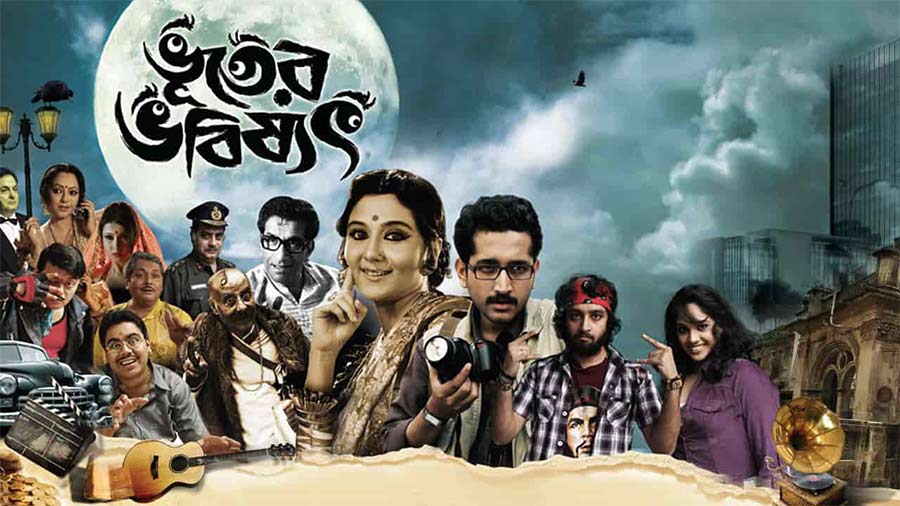
Poster for ‘Bhooter Bhabishyat’, directed by Anik Datta
But the film that proved a turning point for Ghosh was Anik Datta’s Bhooter Bhabishyat (2012), shot with multiple cameras of different models. The parts with the ghosts were shot on a DSLR camera, the real-time portions shot on a Red Digital Cinema camera. Two separate looks had to be given for the two parts, and each ghost in the film was meant to look like they were from different eras. “The separation of tones and colours and look was challenging and was done in Kolkata for the first time. What happened after this is that the directors from Kolkata stopped going to Mumbai and Chennai for this work. At that time, I was the only colourist in Kolkata, in fact I had to start training a few people so that work could be delegated because the volume of work really went up,” said Ghosh.
Ghosh has tried to scale back in recent years, not just because it was affecting his health, but also to do quality work without any compromises. Often, he works on two films parallelly, and starts on a third once he has finished 80 percent of the work on the two. “Images are very delicate, if there is any mistake the whole image gets damaged and I can’t take that risk,” said Ghosh.
Thriller in the morning, black-and-white in the afternoon, then a romantic film
But how does one switch between movies that often have different tones and colours? It used to be more difficult earlier, but now he has found a way of “resetting the eyes and brain” in between films. “I take half an hour or an hour's break, have a cup of tea, look at trees, look at a white page for a bit. This helps reset the eyes and the brain. Sometimes I’ll go home and watch a film or even something like Peppa Pig to break out of the colour gamut that I was in with the film I was working on,” said Ghosh, who often is working on a thriller in the morning, a black-and-white film in the afternoon and a romantic film before he leaves the studio! All three films have three different tones, three different kinds of cinematography and sometimes even different camera mediums.
“Suppose I am working on a thriller which has a lot of green, if my next film is a romance, I will feel like everything is too magenta. If I reset my brain, then I will probably not remove as much magenta from the romance film as I would if I immediately switched from one to the other,” explained Ghosh.
The process of a colourist
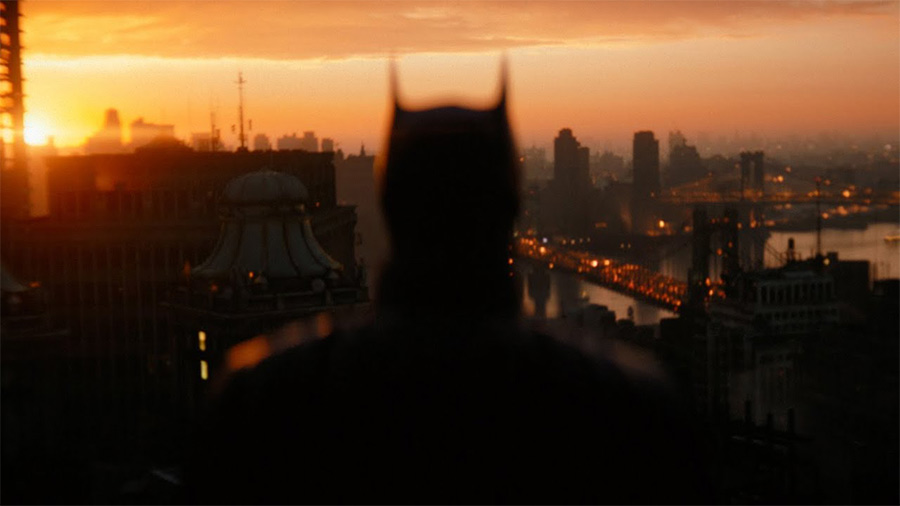
Ghosh tried to incorporate the tone and look of Matt Reeves’ ‘The Batman’ in ‘Tirandaj Shabor’
While it is not always possible to be involved in a film project from the beginning, Ghosh prefers to start right at the beginning, sitting with the director when they are deciding the look for the film — costume, background, locations, appearances of the characters, skin tones and contrasts and what equipment will be used for the shoot. During the shoot when he gets some footage, he makes certain suggestions keeping the tone in mind.
Once the shoot is over and they get the edited footage, Ghosh sits with the cinematographer and the director and chooses some shots from the entire shoot — some night shots, some day shots and in various locations — which they set as per the story.
It is important to understand from the director what the narrative of the film is, what he wants to show the audience and who the target audience is. The look of a film also varies based on the target audience. For example, for a film like Shabor, people who watched The Batman might go to see it and that is the target audience. They would appreciate the play of light and shade or separate tonalities and wouldn’t like to see everything bright and shiny. Based on that, those shots are used to set the look of the film.
“Once I am almost done with the grading, I ask the director and cinematographer to come over and sit for a preview, after which we do some fine-tuning till the film is locked. Sometimes the editor also comes in at this point to see if any transitions need to change after grading,” added Ghosh.
Bollywood vs Tollywood
Doing post-production work for Bollywood and Tollywood is a bit different. “Bollywood productions are a little more professional than us, whether it is in terms of timelines or technicalities. Our system of work is more informal and laidback. It is sometimes difficult to switch between Bollywood work and Tollywood work, but it depends on the team you are working with. If it is a team that understands some of the technicalities and parameters that we work with it is easier to make the switch. Otherwise, it becomes a little frustrating,” said Ghosh.
But not frustrating enough to make him want to move to Mumbai, from where he has had a few offers. He almost joined a studio in Atlanta in the US back in 2017 but was unable to because his father fell critically ill. “At this moment I don’t want to go abroad anymore. Now my target is to do more national projects, which is already happening. There are at least five to six national projects whose grading and colour correction is happening in Kolkata,” said Ghosh, who is pushing hard to get new technologies like HDR to our city.
Work of passion not for awards, but jamai ki kore?!
For Ghosh, his work as a colourist is all about his love for it and not for any accolade. “As a colourist we will never get accolades or win awards but that is not important because this is what I love doing. I could have become an editor where you do get awards, but this is where my passion lies,” said Ghosh, who even found it difficult to explain what his work entailed to his would-be in-laws before he got married! “Thankfully my father-in-law’s uncle was an actor, and he could make them understand that it was a technical job and a good job,” said Ghosh.
His job also means that it is difficult for him to watch films without donning the hat of a colourist, even at leisure. “Usually for the first half an hour of the film I will analyse everything as a technician. I am usually very quiet during that time. If I like what I am seeing, then I sit back and get immersed in it. But if there are problems that I constantly notice I get irritated and start complaining about it. That’s why my friends don’t want to go watch films with me,” said Ghosh.
‘Dune’ and ‘The Batman’
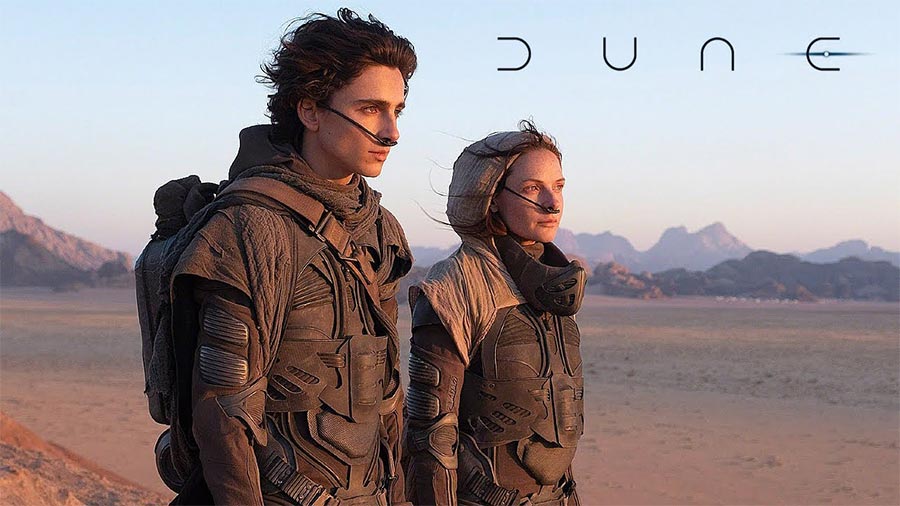
'Dune', according to Ghosh, is technically the best made film in the last decade
For Ghosh, Dennis Villeneuve’s Dune was technically probably the best film made in the last decade. “I read up on the process they used. They shot it digitally then converted it into film and then processed it. That’s why they could achieve that organic look. This is in layman’s terms. There is far more to the process and it is very unique,” explained Ghosh. He also liked Matt Reeves’ The Batman, a look he has tried to incorporate in Tirandaj Shabor.
His dream? To do an international film sitting in Kolkata one day.
